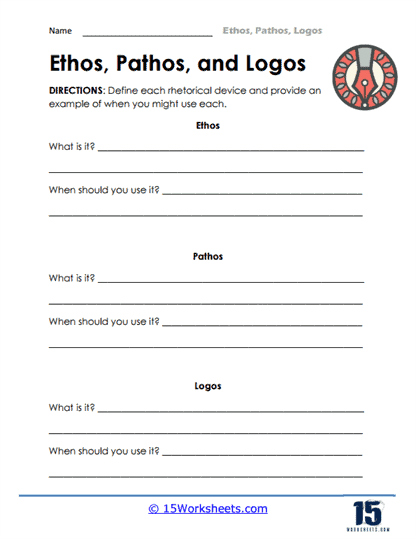Ethos, Pathos, Logos Worksheets

This collection of Ethos, Pathos, and Logos worksheets are meticulously crafted to help students understand and recognize these three modes of persuasion commonly used in writing and speech.
These worksheets include a variety of exercises and activities to help students identify and analyze examples of ethos, pathos, and logos in written and spoken texts. Some examples of these activities include:
- Reading comprehension exercises – Students read a text and identify examples of ethos, pathos, and logos.
- Writing exercises – Students write their own persuasive text using ethos, pathos, and logos.
- Situational response exercises – Students respond to various scenarios using ethos, pathos, and logos.
In addition to these exercises, these worksheets on ethos, pathos, and logos may also include explanations and examples of how these modes of persuasion work, as well as tips on how to effectively use them in writing and speech. Through these worksheets, students will:
- Define ethos, pathos, and logos in their own words;
- Craft their own persuasive texts using ethos, pathos, and logos;
- Learn how to use ethos, pathos, and logos in responding to various hypothetical situations;
- Identify and understand how ethos, pathos, and logos is used in hypothetical real-life scenarios and assigned texts;
- And analyze and appreciate how the three modes of persuasion can be used in writing and in various real-life scenarios.
Overall, worksheets on ethos, pathos, and logos provide students with an opportunity to practice and reinforce their understanding of these important modes of persuasion. Through these worksheets, teachers can help their students improve their ability to analyze and use these modes of persuasion effectively, and become more confident and persuasive speakers and writers.
What is Ethos, Pathos, and Logos?
Ethos, Pathos, and Logos are three modes of persuasion used in writing and speech. They were first introduced by the Greek philosopher Aristotle and have been widely used and studied in various fields of communication, including marketing, politics, and public speaking.
- Ethos – Ethos is an appeal to credibility or trustworthiness. In persuasive writing and speech, ethos is used to establish the author or speaker as an authority on the topic being discussed. Ethos can be established through personal experience, education, professional expertise, or by citing reliable sources.
- Pathos – Pathos is an appeal to emotions. In persuasive writing and speech, pathos is used to evoke emotions in the audience or reader in order to persuade them to accept a certain point of view or take a particular action. Pathos can be achieved through storytelling, the use of vivid imagery, or by appealing to the values and beliefs of the audience.
- Logos – Logos is an appeal to logic or reason. In persuasive writing and speech, logos is used to present a logical argument based on evidence, facts, and statistics. Logos can be achieved through the use of analogies, comparisons, and other forms of logical reasoning.
By using these three modes of persuasion in combination, writers and speakers can create persuasive messages that are both credible and emotionally engaging, while also presenting a logical argument. Understanding ethos, pathos, and logos is important for effective communication and can help learners of English as a second language improve their ability to write and speak persuasively.


